SHERMAN R. POLHAMUS
“TIGER N-72"
I have received many requests for my personal history of boat
racing. To do this I am starting with my history from high school in 1943
as the events that followed are all a part of what and how I became successful
in racing in general. I would like to further state I will name people
that I was involved with and I apologize to any I may inadvertently leave
out.
1943 to 1946:
I was able to attend a Technical High School where I majored in the
ALLISON & ROLLS-ROYCE V12 and the PRATT & WHITNEY 9 & 18 cylinder
aircraft engines. I had a fabulous instructor who not only taught me about
the basics of nuts & bolts, but, most important, he worked with me
many hours after school explaining how cam timing worked, magnetos &
ignition timing, carburetion, differences in metals and why they were used,
etc. About this time I built my first racing engine, which was a CUSHMAN
SCOOTER. I bolted a plate to the piston to raise the compression and had
the camshaft built up with electric weld and ground my own camshaft timing
(on a bench grinder). I was able to raise the speed from about 40 mph to
over 70 mph.
Also at this time I was able to get a job doing minor repairs
on ARMY aircraft engines at the Miami, FL, airport even though I was only
about 15 years old. This lasted until a “bird colonel” saw me working on
his P40 and had a hizzy; so they let me go. I then went to work as a diesel
engine mechanic even though I had no formal instruction in diesels.
1950:
I took a year of diesel school in Memphis, TN. My final exam grade
was 99.7% and we argued about who was right about the .3 %. They made a
plaque (my first trophy) saying I made the highest grade of anyone who
ever attended their schools anywhere in the USA.
1951:
I worked building engines and racing stock cars on the South Florida
tracks. Although I did well at this, I did not like the environment and
soon dropped out.
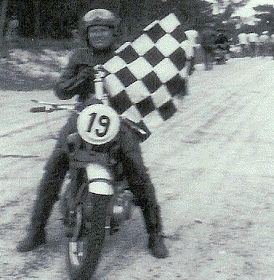
1956 Road Race - 1st place |
1952 to 1963:
I started racing motorcycles and did very well. Back then you could
not buy “racing bikes”; instead I converted a street motorcycle. I chose
a brand that I liked, built-up the engine and won many motor-cross (dirt)
races but it was not suitable for hard surface racing (road racing &
flat track). I did race twice “on the beach” at Daytona but the best I
did was about 10th. I also road raced a VINCENT BLACK SHADOW (the fastest
production motorcycle at that time; about 140 mph) I souped it up and was
running about 170 mph top speed, plus a VINCENT LIGHTNING for drag racing.
Got it under 8 seconds in a ¼ mile. |
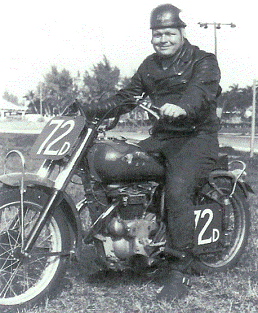
AMA professional racing |
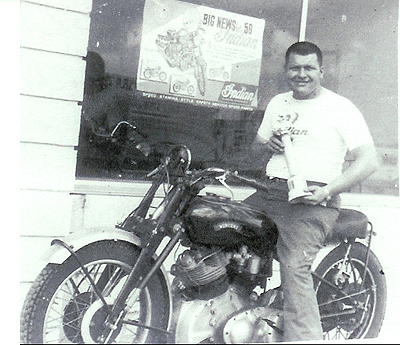
1956 - 1/4 mile 7.996 seconds |
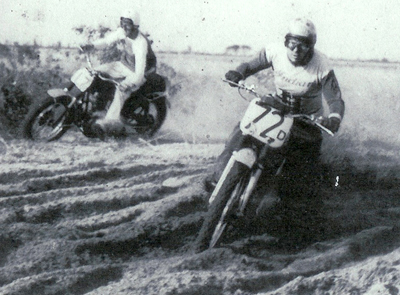
1958 motorcross - 1st place
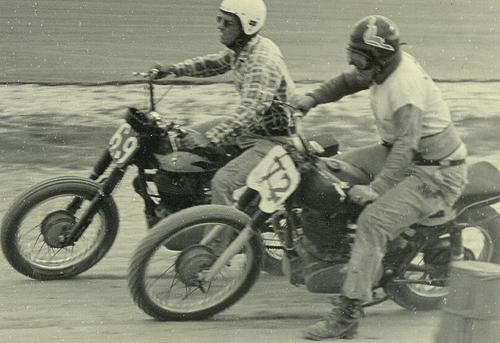
1963 last race - 1st place |
|
In addition, I was very good at endurance runs (cross country events
in which you had to maintain a set speed like 24 mph and you lost points
if you were early or late at various check points). Back then you did the
calculations in your head as you drove. In about 11 years a good friend
and I won about 98% of these events. I had a perfect score approximately
25 times (no points lost). I was one of only two people in the State of
Florida that had a “Class A Enduro” license. My last race was at West Palm
Beach in 1963.
1967:
I was returning from a fishing trip when I chanced across a boat race
in the Miami Marine Stadium and stopped to watch.
I went into the pits after the race and talked to some of the drivers
as I was immediately drawn to this sport.
As if pre-destined, I was discussing this later with a motorcycle customer
William (Hutch) Hutchins, known for outboard racing,
and he told me about a local made 280 that was for sale,
Viola.
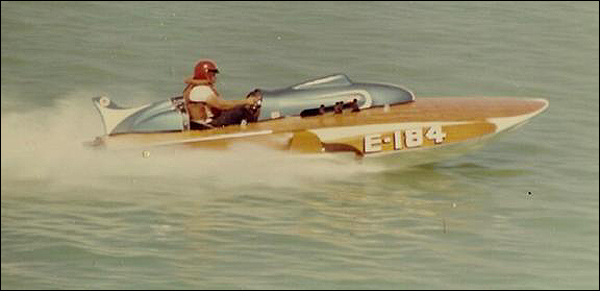
I bought my first racing hydroplane E184 with a Chevy and trailer
for $1000.
I named it TIGER, as this was one of the model motorcycles I
sold and I was already known as TIGER from my motorcycle racing.
I joined the Florida Inboard Racing Club (I became president later)
and became good friends with all the members, especially John Onkey, who
was successful racing the BALD EAGLE 280.
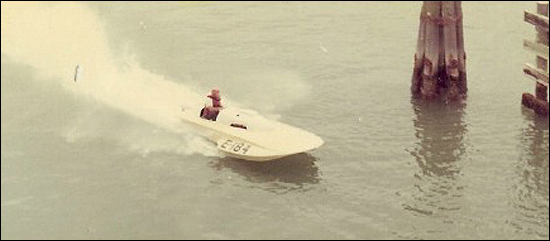
Marathon Race Photo
For the next two years I did extensive testing on both his boat and
mine. I not only worked on the engines but also studied the aerodynamics
of the top of the boats and cowlings and the shape and effects of the sponsons.
Alas, the best I could do was a few 2nds. I did run it in a marathon race
from Miami to Key Largo, a round trip distance of about 140 miles run over
two days. I installed an EXTRA 12 gallon tank in the front and was running
out of gas at the end of each direction. I won this event and received
a nice trophy.
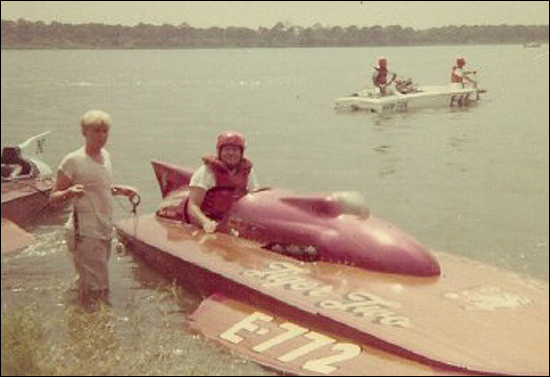
Tiger Two E-772
1968 to 1970:
I bought a brand new Lauterbach 280, E-772 from its owner in Newport,
Ky.
Again I was not really succeeding in the 280 class.
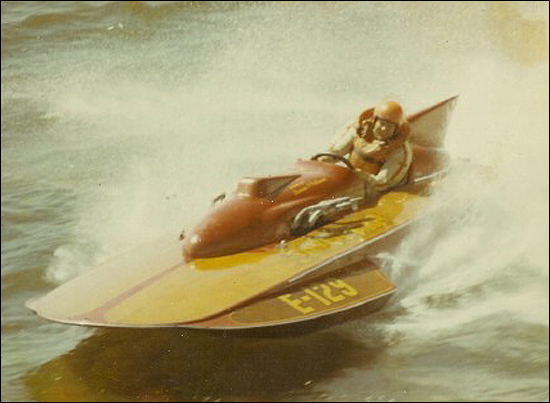
Sayonara E-129
A few more 2nd places and I sold the boat, and bought a used 280,
Sayonara
E-129 from Tom Sheehy that had been winning.
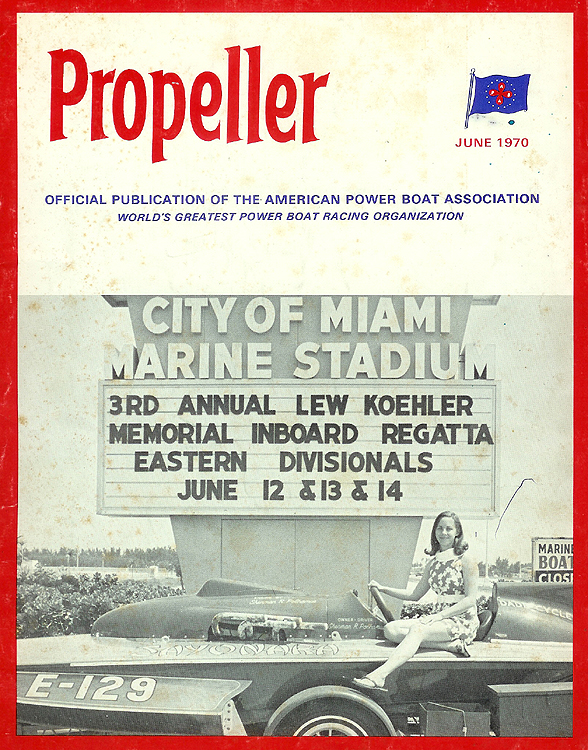
Try as I may I still was running mostly 2nds and a couple of 1sts.
I also tried the Plymouth engine and ran faster but burned out the
main bearings four times; once while leading the Eastern Divisional.
Finally I altered the lubrication system and kept mine and several
other local racers engines together.
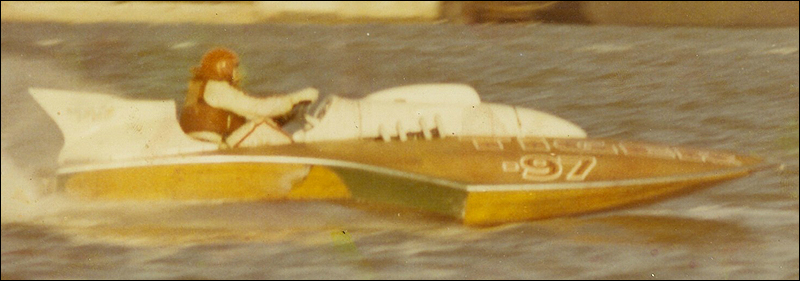
About this time someone laughingly said the reason I could not
win 280s is because I weighed 225 lbs and I should switch to the 225 class
so I bought a “Colcock” barrel top 280 E-97 and converted it to a 225 using
a BUICK engine. On my first engine I had help from Jack & Harold Wilcox.
When I ordered the intake manifold the only thing available was a 4-barrel,
which turned out to be a fantastic “mistake”. I won five races with this
boat in a row. A major problem developed as the boat was too light. I had
to bolt over 100 lbs of lead to the inside to bring it up to legal weight.
As I developed more powerful engines the boat became uncontrollable at
the end of the straight-a-ways and became totally airborne several times,
so I sold it in 1970.
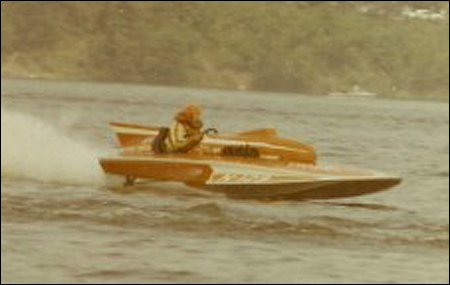 |
1970 & 1971:
I bought a used Lauterbach 280 thru Tom D’Eath
and converted it to a 225 N-129. |
I won seven races in a row with this boat.
I intentionally started behind the pack at the 1970 Ypsilanti, MI.
Nationals as I felt I didn’t have a chance against all those beautiful
new boats.
As it turns out I still came in 4th.
I was Region 5 High Point both years. |
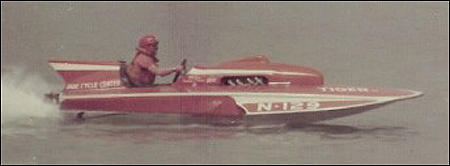 |
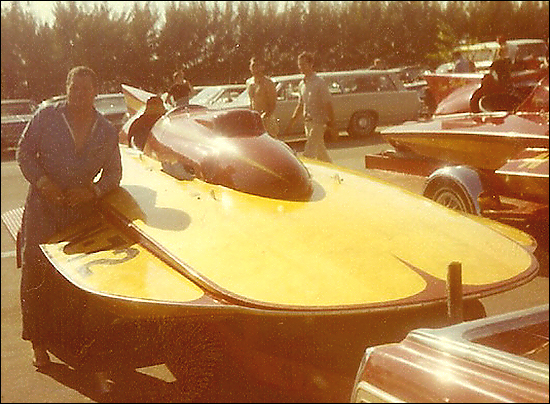
1971 & 1972
Starting at this time I may not have every fact in exact order as from
here on I must cover the many different things that occurred (boats, engines,
propellers, racing strategy, etc.) to achieve the final results I obtained
over the following years. While I was in Ypsilanti I met Henry Lauterbach and ordered a
new 225. I took delivery of my new TIGER N-72 in the spring of 1971.
I had built the first of my “super” engines for this boat. From then
on Stan Irwin’s machine shop worked with me to make all my future Buick
engines 228 cu.in. This required boring out the block and installing new
larger steel sleeves. This Tiger N-72 and Joe Siracusa’s Country
Boy N-8 were built at the same time. My first race was the Miami, Fl. Eastern Divisional. I won 1st Place.
This boat won many races in the coming years.
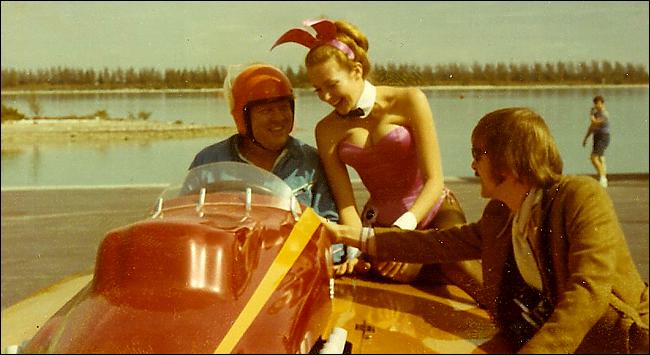
Miami Playboy Race - 1971 - Miami Marine Stadium
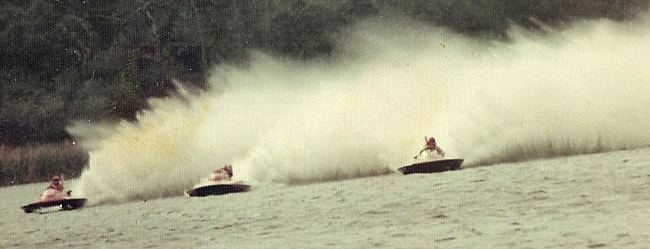
St. Petersberg - 1971 - second race, 1st place
My second race was part of a two-weekend race at St. Petersburg, Florida.
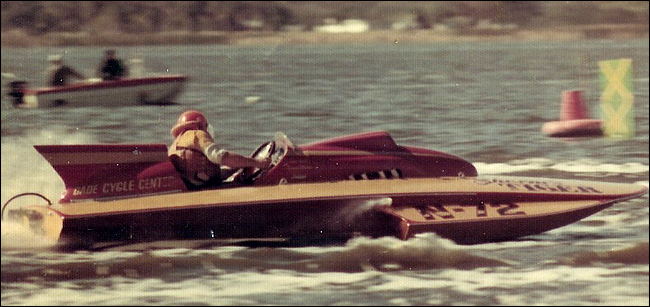
St. Petersberg - 1971 - third race, 1st place
My third race was at St. Petersburg. I won 1st place but I blew the
head gasket and burned a slot in the block.
I went back to Miami and installed my previous 215 cu.in engine.
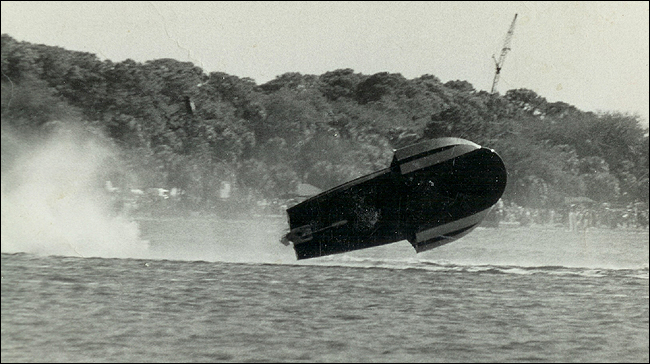
My fourth race I soon found out the boat did not perform well with
this less powerful engine.
The net result was the boat “flipped” (my only racing accident) and
did considerable damage to both me and the boat.
Steve Jones pulled up in his 225 and held my head up until the rescue
boat arrived.
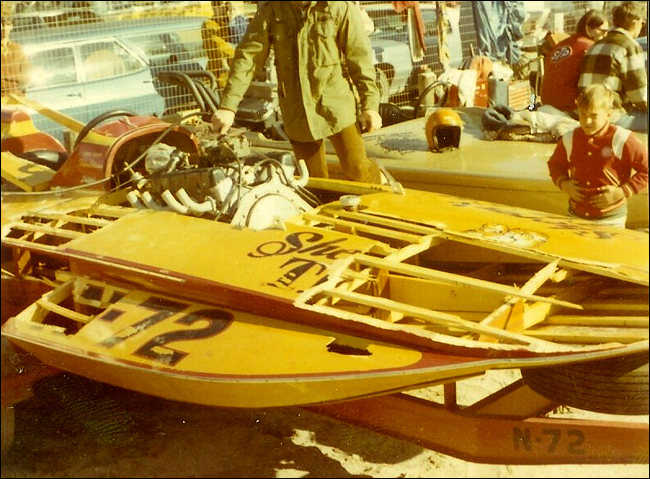
Walt Carter helped me out by taking the boat back to Norfolk, Va. for
Henry Lauterbach to repair.
My crew chief and very good friend, Jess Thrash, drove my car home
and another good friend, Gene Bramblett, took me home in his RV.
What a great bunch of guys! After a great deal of talk to convince my wife that I would never
do it again, I rebuilt my super engine and replaced the head bolts with studs that had about ¾ inch of thread in the block &
70 ft.lbs of torque (more about this later) and was soon racing again.
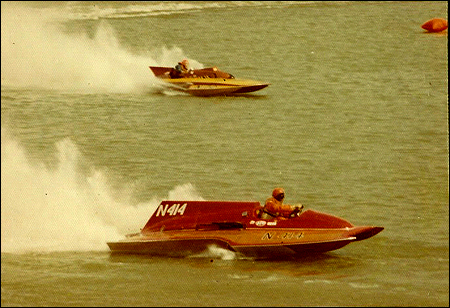 Stuart, Florida - 1st Place Stuart, Florida - 1st Place |
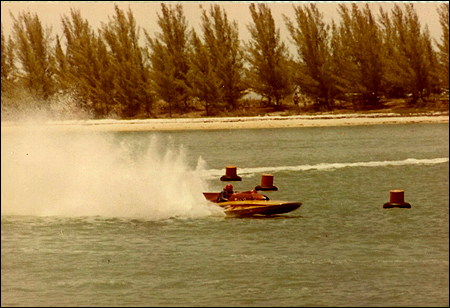 Miami, Florida - 1st Place Miami, Florida - 1st Place |
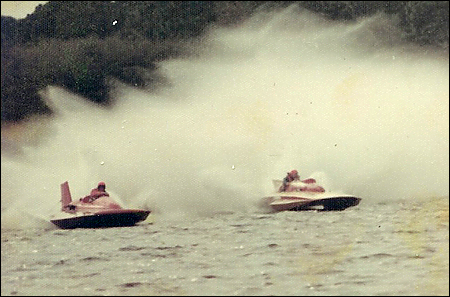 Mt. Dora, Forida - 1st Place Mt. Dora, Forida - 1st Place |
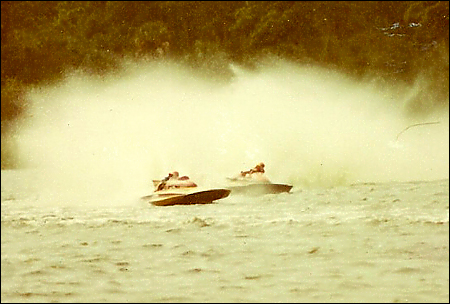 Ocoee, Florida - 1st Place Ocoee, Florida - 1st Place |
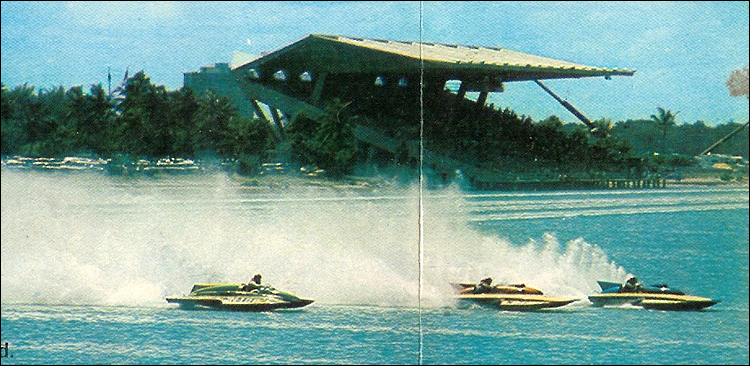
About this time the City of Miami publicity department published a
promotional flyer with
Tiger, Country Boy (Joe Siracusa) and Speculation (John Woods) in the first turn at the Miami Marine Stadium.
They also arranged for me to test my boat anytime at the stadium which
really helped as it made it possible for me to try out new engines and
props, etc. as often as four or five days a week. At this time my engines
had a power curve of about 4000 to 7500 rpm. Please note how this changes
after 1972.
In 1971, I won 20 of the 22 races I ran in.
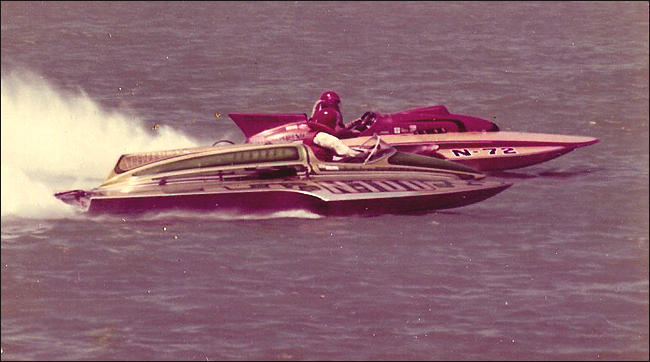
Tiger with John Woods’ Speculation
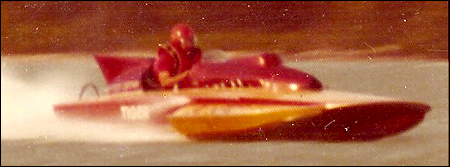
In 1972 I won somewhere around 35 or 40 races all over the eastern US.
I became National High Point and was awarded N1 for the year of 1973. Also
in 1972 at the Miami Unlimited races, the manager of the Champion Spark
Plug racing division came over to me and told me he could not only help
me with spark plugs but also put me in contact with the “right people”.
From then on I received many camshafts, pistons, and other parts from all
over the country. I think the most important was my contact with the Holly
carburetor racing division who straightened out my assumption that “the
bigger the carb, the more power” I was racing with an 850 double pumper.
They sent me several standard auto replacement carbs and I ended up with
what they first recommended--a 560 single pumper with a vacuum secondary.
To illustrate my testing and the effect that this carb had, I would check
my time from the center buoy in the first corner to the first buoy in the
second corner. I went from 29 seconds to 22 seconds just by changing carbs.
Several years later, I got this time down to 16 seconds. Later I did obtain
a 2-2 intake manifold and Holly sent me many 2-barrel carbs. I tried many
combinations and ran them with modifications to the power valves and other
ideas. They never obtained the overall performance of the 4-barrel.
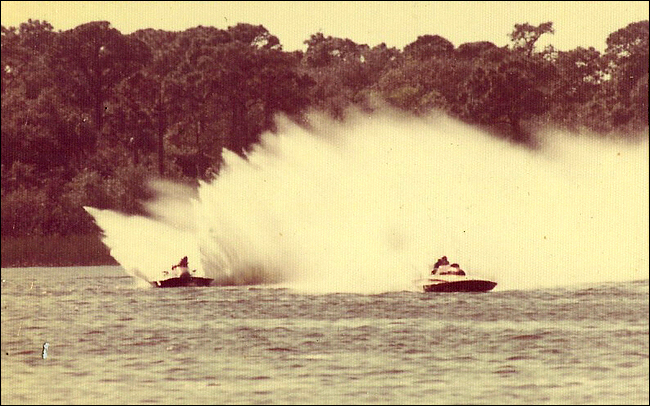
St. Petersburg, Florida - 1972
In 1972 as I started to obtain more & more power with the help of
the “right people”, I started to have more engine failures. The first I
remember was getting new higher compression pistons (I later worked with
this piston company on various weight and different configuration pistons;
experimented with different offsets of the wrist pin holes, etc), which
soon resulted in a bent Buick connecting rod. Stan Irwin showed me a Chevy
rod which was stronger and the same basic dimensions but wider at
the crankshaft end. He figured out a way to machine these connecting rods
to replace the Buick rods from then on. The next problem was excess
main bearing wear both on the bottom and the side due to the gyro action
of the aluminum flywheel. I tried the hydromantic tin flywheels and sheared
off 10 flywheels in 10 races. I was also having some crankshaft wear but
the crankshafts cracked after about 15 races anyhow. Then I noticed that
the oil rings were causing wear to the cylinders at the top of the stroke.
I was put in contact with Perfect Circle racing division and they made
me “Malloy filled” compression rings (correct size for my bore) and 3 piece
oil rings that were .020 undersize with specific instructions. The block
had to be honed with a very fine finish and I was to line up the gaps on
all the rings in line with the wrist pin. This stopped the wear and I gained
a couple of seconds on my test time. The next problem came
with a better camshaft and more horsepower, which caused several problems
at the same time. I blew head gaskets again so I found out about a place
in Ca. that made studs to order. I received grade 8 studs with 1 ½”
in the block and torqued the heads to 100 ft.lbs. Then the main bearing
caps started breaking (one sheared off completely). I purchased longer
studs, machined the main bearing caps flat and covered them with ¾”
steel straps. By “accident” I solved the bearing/crankshaft wear. I was
already using the timing cover from a larger (315 ? cu.in) Buick engine,
which had a larger oil pump. I was in St. Petersburg and when I started
the engine on a very cold morning I noted that the oil pressure was LOWER
rather than HIGHER. This could only mean that the suction side of the oil
system was too small. I built a new oil pan which had a ½” filter
pipe and ran it through the side of the pan. I then drilled out the block
to ½” back to a mounting bracket boss and installed a fitting with
½” inside; connecting both with a “U” shaped pipe and hoses.
I heard about a person that did racing head work in Ca. In our discussion
I told him how the BUICK “Tulip” valves stretched above 7500 rpm. He used
TRW Oldsmobile flat head valves, which were slightly larger and had to
be machined to 1.500”. He also installed brass inserts in the valve guides
as well as normal porting, etc. From then on I had Stan Irwin do my head
work BUT I found out that TRIUMPH motorcycles used solid brass valve guides
which fit with a little machine work. I also machined a cup and grooved
the guides to trap and hold oil inside the guide. This picked up about
300 rpm. By the end of 1972 I was up to 7900 rpm. One other notable event
happened on my way back from Dayton, Ohio. Somehow the trailer came off
the car near Ringgold, Georgia. As luck would have it; it stopped in the
north bound lane of I-75 at night and a car hit it broadside doing
a great deal of damage to the entire rig. I rented a truck and hauled the
remains to Norfolk, Virginia for Henry Lauterbach to repair.
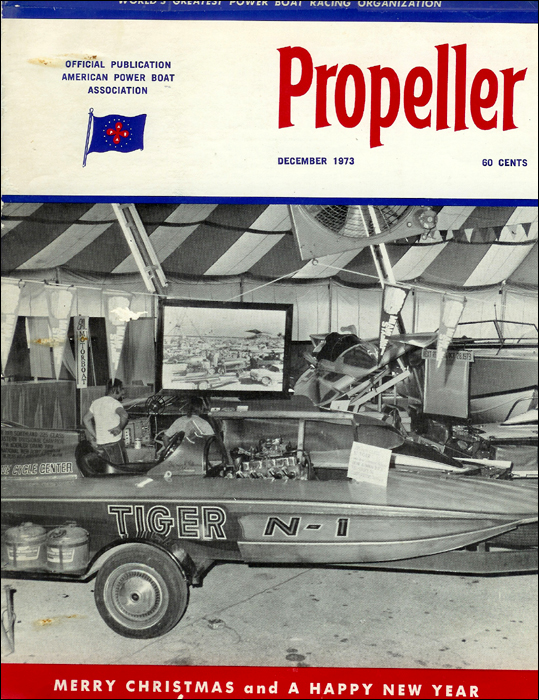
1973
I ran with the number “N-1” and won about 30 to 35 more races.
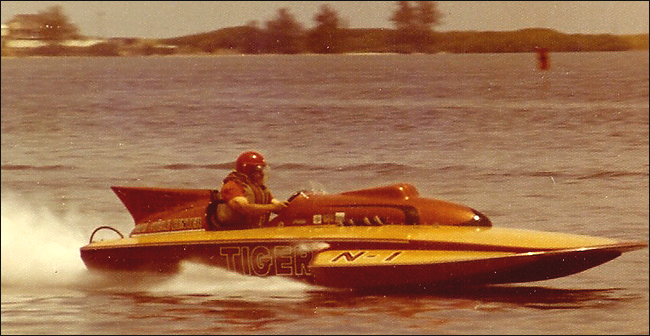
Jess Thrash drove my boat to many places like Guntersville, AL, Morgan
City & Baton Rouge, LA,
Raleigh, NC, New Martinsville, WV, Tonawanda, NY, and Canada.
|
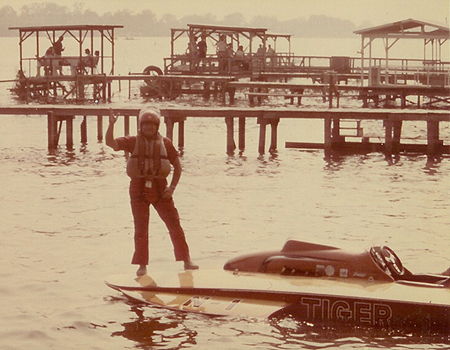
Baton Rouge, Louisiana
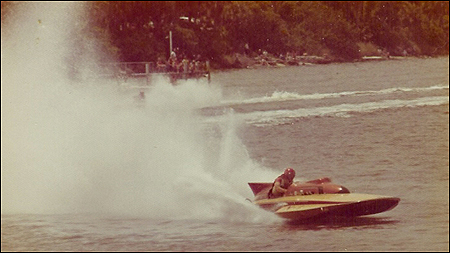
New Martinsville, West Virginia
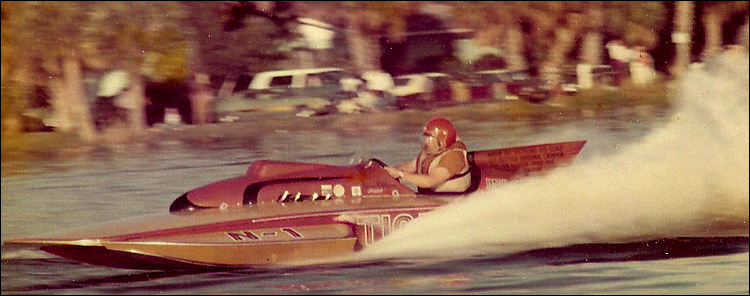
Port Arthur, Texas
I flew in for many of these races. At Baton Rouge I had reached my limit
of 15 races on that engine and I drove back to Miami and put in my other
engine (I kept two going at all times) and then to Raleigh, NC, where I
had one of my most memorable weekends. In two days of racing I won all
four heats of 225, I ran over the completion record in every heat but not
enough to break the record. I was very consistent as the speeds were all
within ¼ mph. of each other. Further; David Irwin who was
maintaining Lou Nuta’s ROMAN CANDLE 5 liter asked me to drive for
him. I won three out of the four heats and would have won the last but
the propeller shaft bearing burned up and CAUGHT FIRE. I ran the last lap
wondering if I could finish, which I did and immediately drove over to
the dock and abandoned the boat while they put the fire out (whew!)
Another incident happened in Morgan City which helped me a great deal in
return. There was a new (to me) 225 in the race. I noted that he was running
very slowly and I asked the owner if I could help. He agreed to let me
check the engine and I found it out of time on both the camshaft and ignition.
We took it apart in the pits and corrected the problems. He said he picked
up 2000 rpm. This owner turned out to be Louis Baulman who specialized
in doing racing propeller work. For many years we discussed the effect
of the configuration of props and how they affected the boat. He also sent
me dozens of props to try. I also set a new KILO record at the races promoted
by George Baker (one of the finest gentlemen I ever met) at Daytona Beach,
Florida but the completion committee would not allow it because of some
problem with the scales that weighed the boat(s). By this time I was have
trouble getting 95-octane gasoline because of the pollution laws. A chemist
customer put together a test kit so I could check the gas at the pump.
The end of 1973 I was still turning 7900 because of valve float. I sold
this TIGER and ordered another TIGER from Henry Lauterbach.
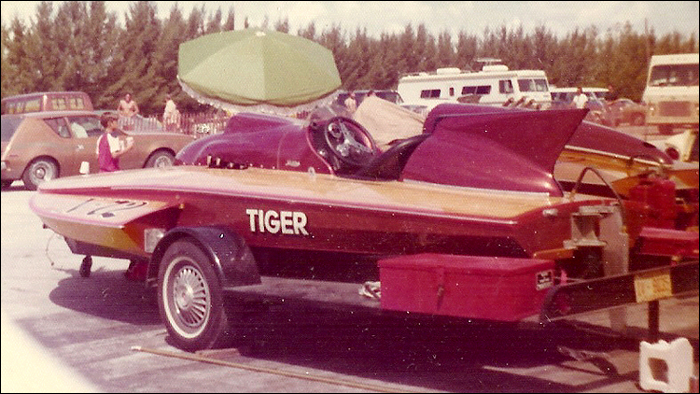
1974 & 1975
I had more input on the design and construction of this boat. Both
Henry and Larry Lauterbach listened to my ideas and worked them into the
boat. I won the first race with this boat but it was “down” on the bow.
We decided to deepen the sponsons when I came up with a different idea,
which worked out extremely well. Larry was going to deepen the entire width
of the sponsons from front to back. I got him to put in a narrow strip
on the inside-bottom of the sponsons starting with nothing and tapering
it to about 1” deeper at the back. This “trapped” the air but did not have
the “drag”. His hesitation was that it produced a sharp corner in the middle
of the sponson, which turned out to be perfect. While I had to “blip” the
throttle on the first boat to turn the corner, I could run this boat into
the corner of any course at full throttle. Once the race started I kept
the “peddle to the metal” the whole race. Now I had a camshaft that had
so much lift that the valve springs would coil bind; again Champion came
to the rescue and put me in touch with a firm that made valve springs.
They supplied me with several combinations of springs until they worked
up to the 8600-rpm range. This started the rocker arms and rocker shafts
to break. To support shaft ends, I threaded the inside hole at the ends
and bolted straps down to bolts through the side of the cylinder head.
Although I highly polished the rocker arms, they continued to break and
the metal pins that contacted the valve stem would come out. I kept six
rocker arm sets with me at all times and would sometimes change them between
heats. Also at this rpm the starter ring would come off the flywheel from
centrifugal force. Stan Irwin solved this problem by welding brackets to
the ring gear and bolting it to the flywheel. I later came up with the
idea of “no flywheel” at all. I found an aircraft starter that engaged
the engine with three “jaws”. I made a matching three jaws to bolt to the
crankshaft and that solved the flywheel problems. I then went to two small
batteries, as 24 volts would crank the engine at about 1000 rpm.
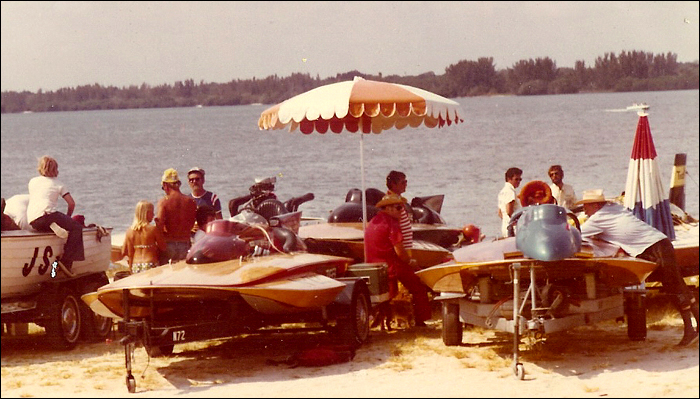
Stuart, Florida 1974
I won many more races with this boat and would have won the 1974 Nationals
at Dayton, OH except for a problem with the valves.
While checking after the race the inspector found one of the intake
valves was 13 thousands oversize (1.513) and I was disqualified and suspended
for six months. Really, no hard feelings; rules are rules!
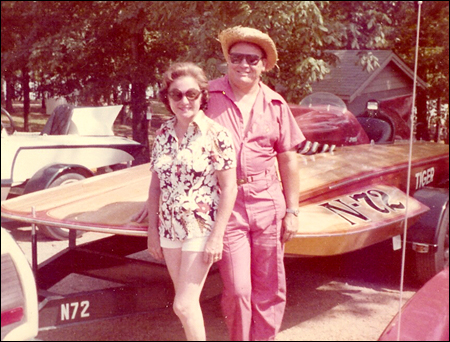
Sherman and wife Frances at the races
I was over my suspension for about one week when I set the kilo record
at Daytona Beach, Florida (again) at 134.636 mph. By this time I was altering
the props in both diameter and blade configuration. I would grind them
down on a bench grinder and polish them with a “flapper wheel”. I made
a short shaft on which I installed ball bearings to balance the props.
For the kilo I used a 26” pitch, which I could not get up to speed as it
came. My engine now had a power curve from 6000 to 8600 rpm. To get the
prop to work, I narrowed the width of the blade until it would cavitate
like crazy. It still took over ½ mile to get up to top speed and
I ran the “traps” both ways at 8600; holding my breath hoping nothing would
go wrong. I also altered my completion props. If I used a 21” prop,
I would be over revving at the end of the straight a ways. What I did use
mostly was 22” or 23” props, which would “bog-down” in the corners. So
I altered both the diameters (some were 10”) and/or I narrowed the outer
edge of the blades so that they would slip in the corners but hold when
I got up to speed. I was “clocked” on the 1-2/3-mile course in the Miami
Marine Stadium at over 120 mph at the end of the straight a way. I still
hold the Miami and many other racecourse competition records. About now
another problem showed up! I had my engine dynamometer tested in Daytona
by some people that built racing stock cars. They found out that I was
getting 320 hp @ 7500, 355 hp @ 8000 & 330hp @ 8600. That is about
1 ½ hp per cubic inch. All this hp produced another problem I could
not solve precisely and that was the aluminum block failed. A “V” shaped
section of the block broke out from the main bearing to the camshaft hole.
This caused the engine to vibrate so badly that it spun off the oil filter.
The first time this happened I got a shoe full of hot oil and a second-degree
burn. I solved the oil filter problem with a hose clamp and safety wire
to the pan bolt. This happened three times so I went back through my records
and found all my failures were after 12 to 15 heats so I started replacing
the engine after 10 heats of racing and never lost another engine. During
this year I also ran 5 liters, stock and full race 7 liters and Grand Prix
boats for other people. I am not sure but I think I was nominated for the
APBA Hall Of Fame and I know I was inducted into the Gulf Hall of Fame.
About this time I was also named GPR#1.
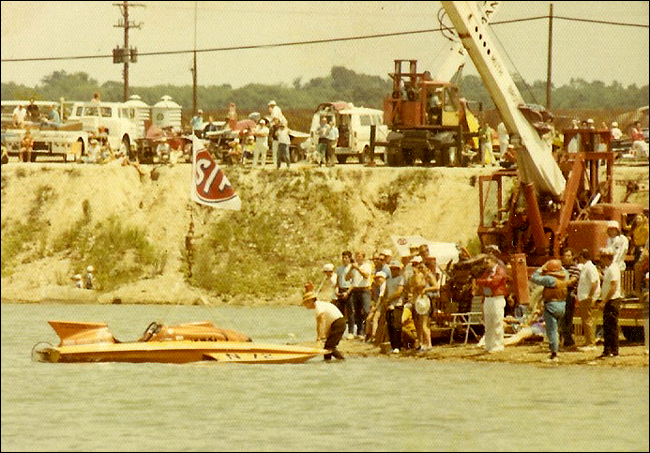
World Championship - 1st Place - Dayton, Ohio 1976
1976
I started to not attend as many races as I developed myasthenia gravis,
which is a muscle weakening disease. I ran mostly in the Florida area but
I did win the Nationals in Morgan City, Louisiana. In the first heat I
was leading but the pleasure boats outside the course made such high wakes
I could not hold on to the steering wheel and I ended up 2nd or 3rd.
I was so rung-out they had to lift me out of the boat. I asked another
driver I know to drive the second heat for me and he said, quote, “Get
you’re a__ back in the boat and show all these people that you are a championship
driver”. The second heat I got the lead and never looked back. The
pleasure boats were gone and the lake was smooth. I understand I had a
½ lap lead over 2nd place. This year I solved my final failures;
by this time I was twisting off 1” prop shaft every 2 or 3 races so I went
to a 1-1/8” shaft. I then had to obtain another set of props for the larger
shaft, most of which I got from Lou Baulman.
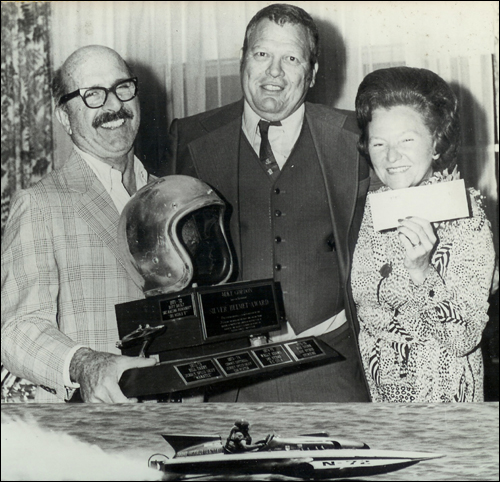
1977
Most of my races were at the Miami Marine Stadium and in Florida.
I won the “SILVER HELMET AWARD” sponsored by Mike Gordon as I had more
points in Miami than any other boat.
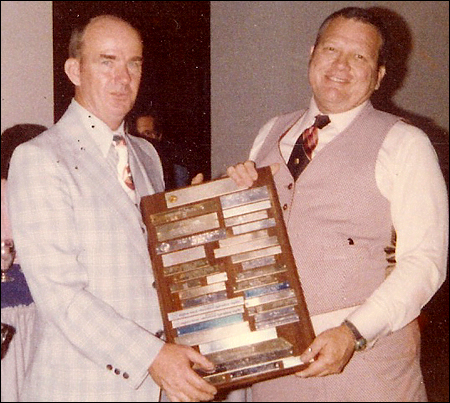
Special lifetime achievement award of first place plaques awarded by
Walter West, President of Florida Inboard Racing Club.
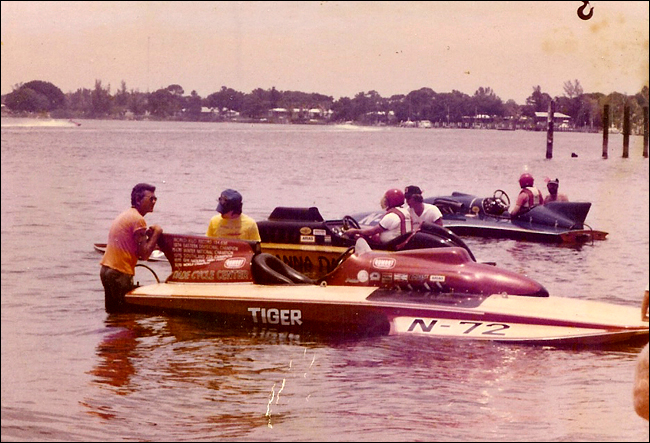
1977 – St. Petersburg, Florida - 1st place
One of my last races was at St. Petersburg, Florida, in 1977, which
I won. Then, I had other drivers to continue racing the boat until the
engine got tired and then I sold the boat to Jim Derncourt, who later sold
it to Carl Wilson. I sold both of my engines to other competitors. I built
one Oldsmobile racing engine that would only turn 7500 so I sold it to
a fellow in Australia who later told me he raised the record 10 mph with
this engine. I also sold engines to Barbados for a racecar, Italy for a
race boat, England for a racecar, and about ten Chevy, Plymouth and Buick
engines to fellow racers.
Notations in my scrap book show:
I won the ’71-‘73-’75 Southland Regatta;
'71-74-76 Eastern Divisionals;
'74* (disqualified) –’76 Nationals;
’75-’76-’77 Grand Prix;
’76 Worlds Championship:
Kilo record (twice): I won over 200 races in my career and had my boat
in many newspapers including The New York Times, Wall Street Journal, etc.
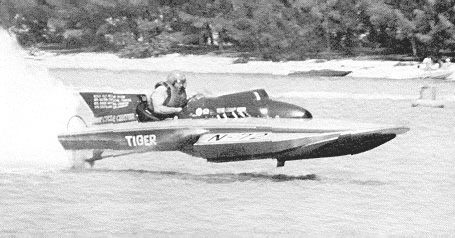
A beautiful picture
from Powerboat Magazine
of the TIGER in action at the
Miami Marine Stadium
when I set
the course record of 86.580 mph.
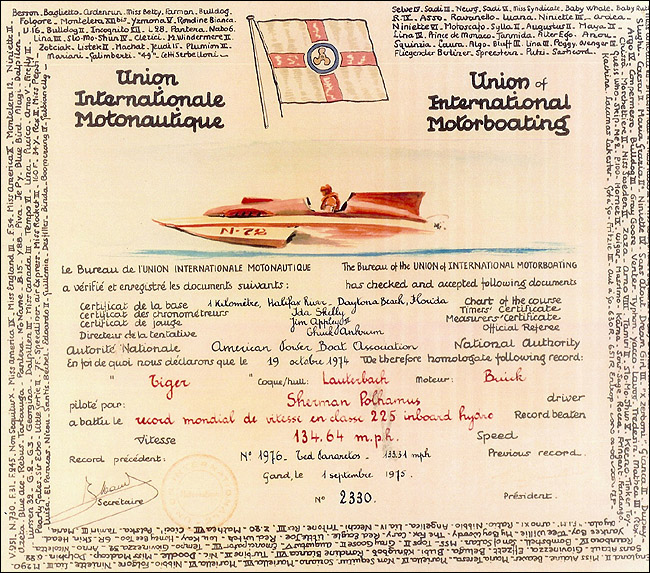
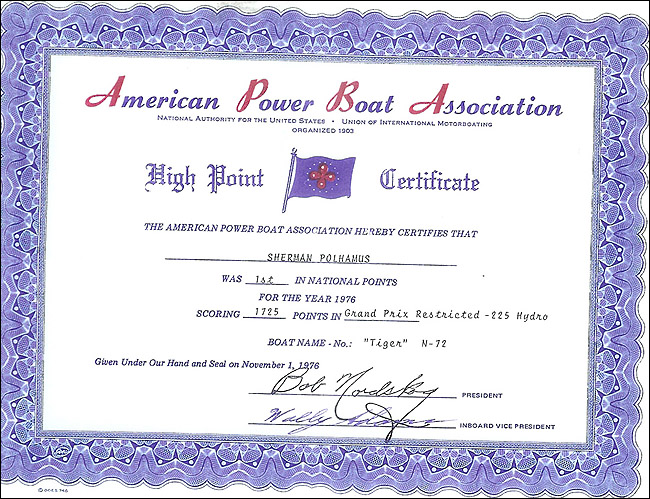
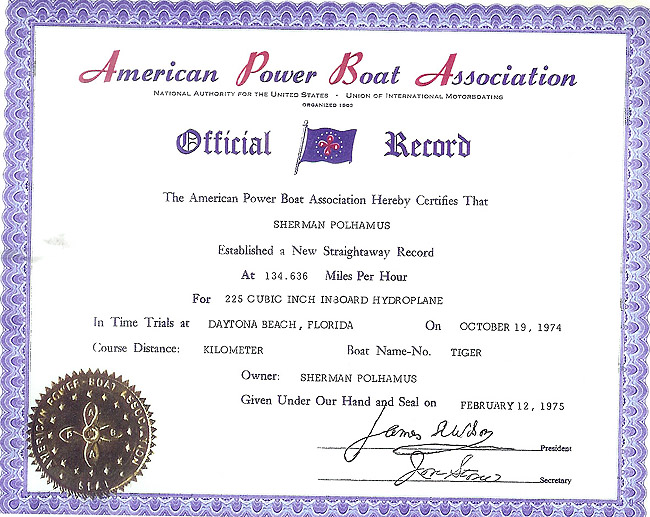
The TIGER has now been beautifully restored by Carl Wilson who did a
fantastic job and it looks just like the last day I raced it. Thanks, Carl! |
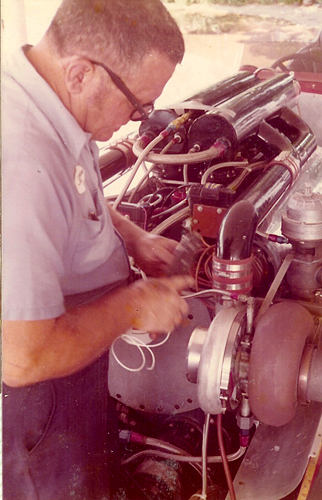
Sherman working on Allison aircraft engine.
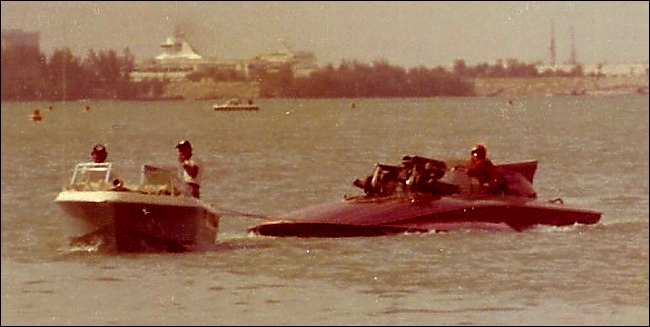
My involvement in boat racing continued with an Unlimited Hydroplane
owned by Carol Kerns & Walt Carter.
This boat was built by Henry Lauterbach and had an Allison Aircraft
engine with turbo chargers and fuel injection.
I could not handle the driving so Carol got Steve Jones to drive for
us. After much confusing, incorrect information about the fuel system,
I finally got it running properly. It kept breaking connecting rods and
Carol would send the engines back to Texas to be rebuilt BUT they kept
using the same accessory section.
After the third engine I took it apart and found a broken gear that
timed the ignition. My assumption was that the timing would change causing
excess pressure on the rods. We bought a WWII surplus engine in Marysville,
Ohio and Tom D’Eath let me use his workshop to rebuild this engine.
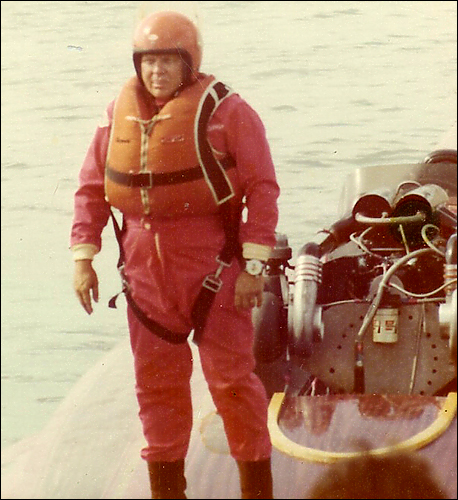
While I was at it I altered the cam timing and did a couple of other
things and got it running so good that it demolished the gear box in Dayton,
Ohio.
Carol then decided to go with a different style of power system so
I dropped out.
News Clippings:
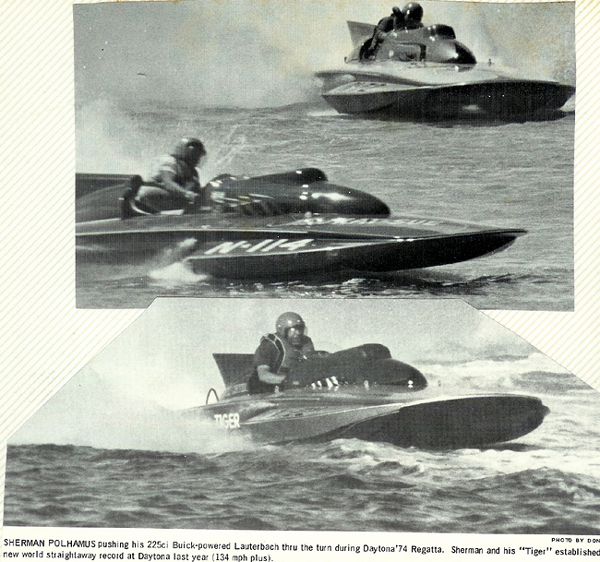
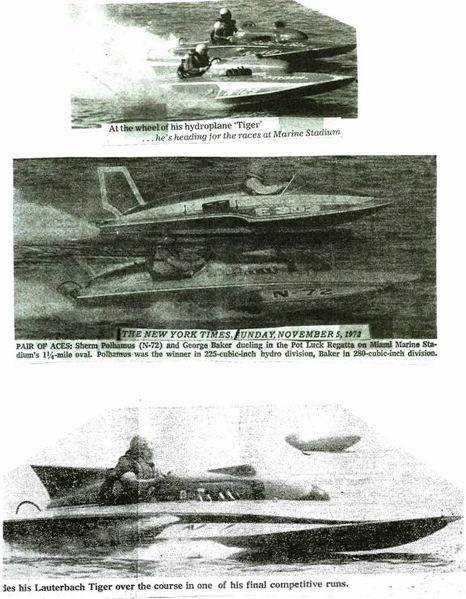
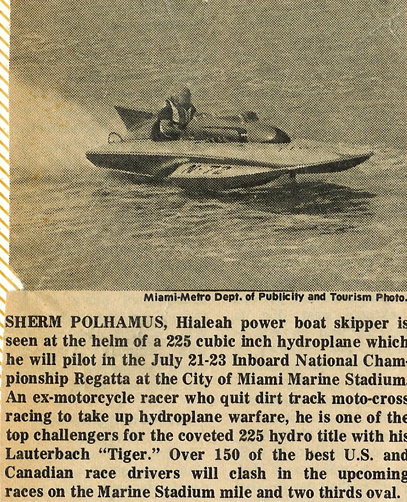
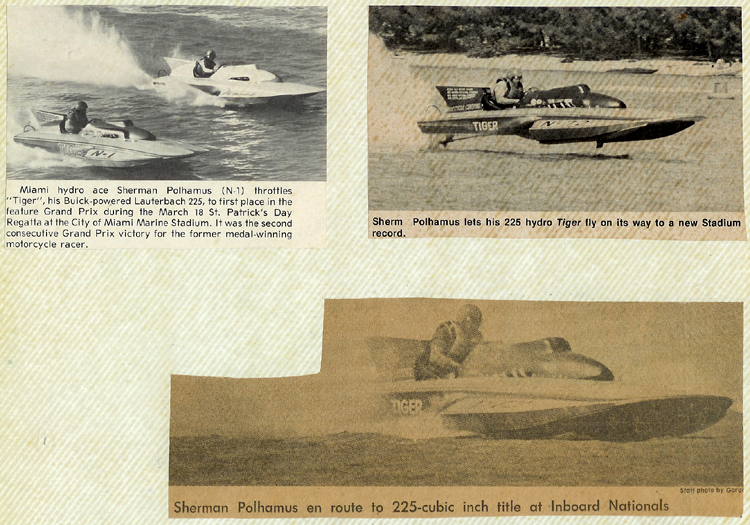
Tiger (http://www.vintagehydroplanes.com/tiger.html)
today as restored beautifully by Carl Wilson
In summary I would like to say that the eleven years of boat racing
were the best years of my life.
I met so many fine people and we all had so much fun and camaraderie.
I immensely enjoyed working on the engines and other aspects involved
in boat racing.
SHERMAN R. POLHAMUS
Sherman & Tiger N-72 reunited after 31 years in Celina,
Ohio 2008
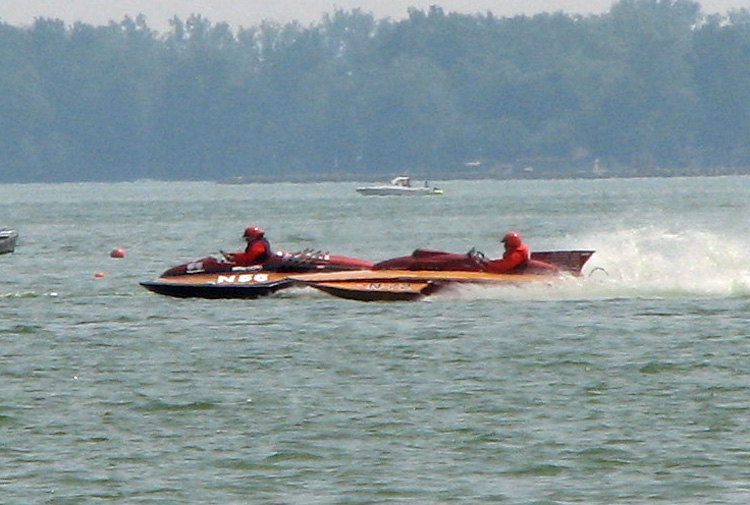
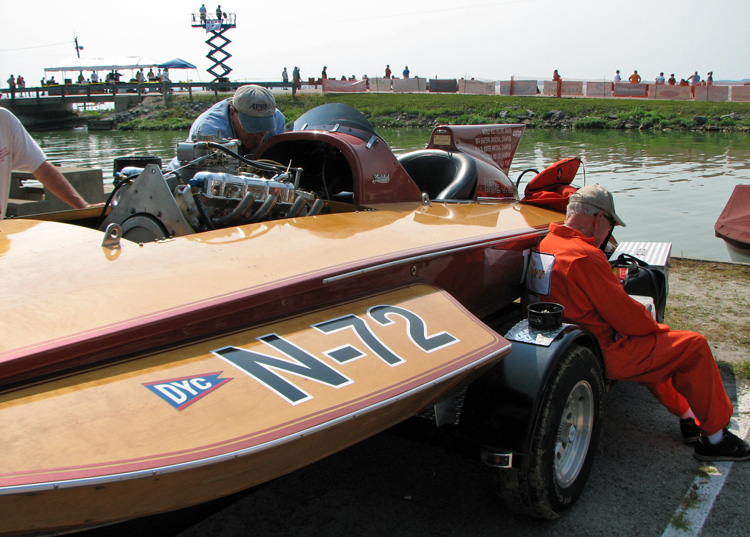
Ed Wicks getting TIGER ready to ROAR
Bill Benning photo
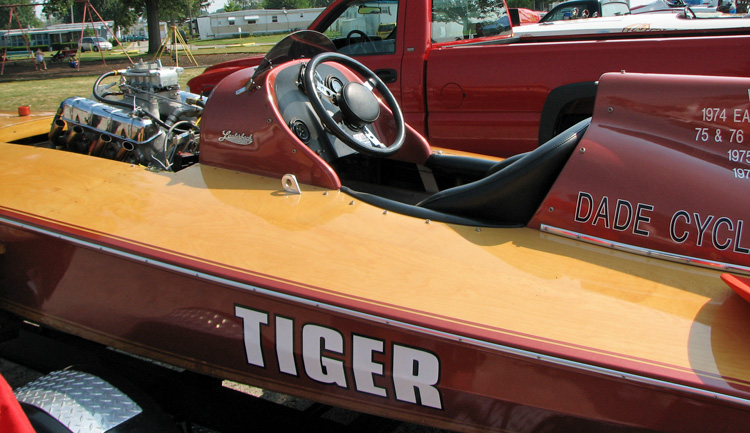
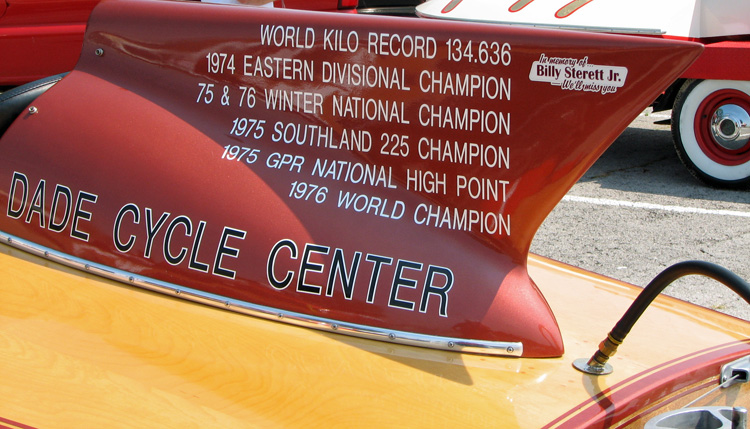
Accomplishment & records by Tiger N-72 & Sherman Polhamus from
1974 to 1977
Bill Benning photo
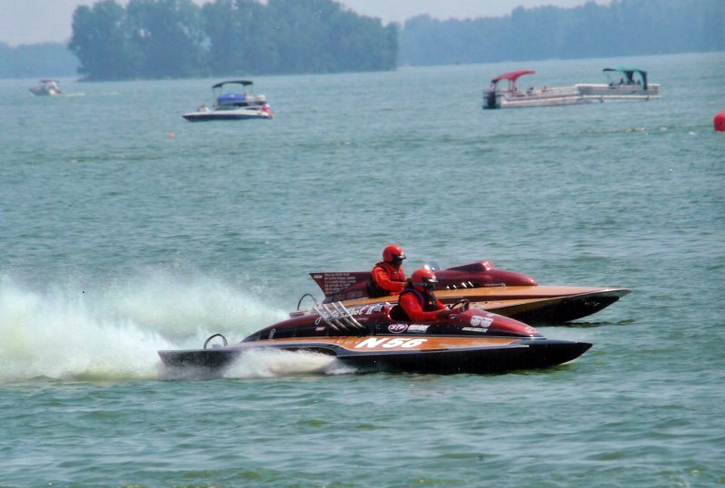
N56 JUSTA PEST - Ed Wicks & N72 TIGER
- Sherman Polhamus driving
Bill Benning photo
Back to the photo albums
|
|
|
|